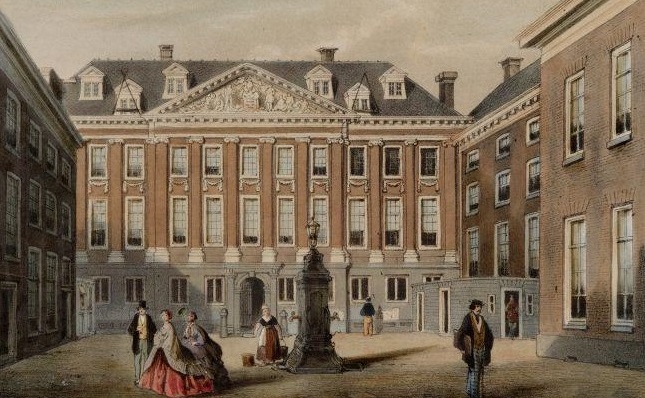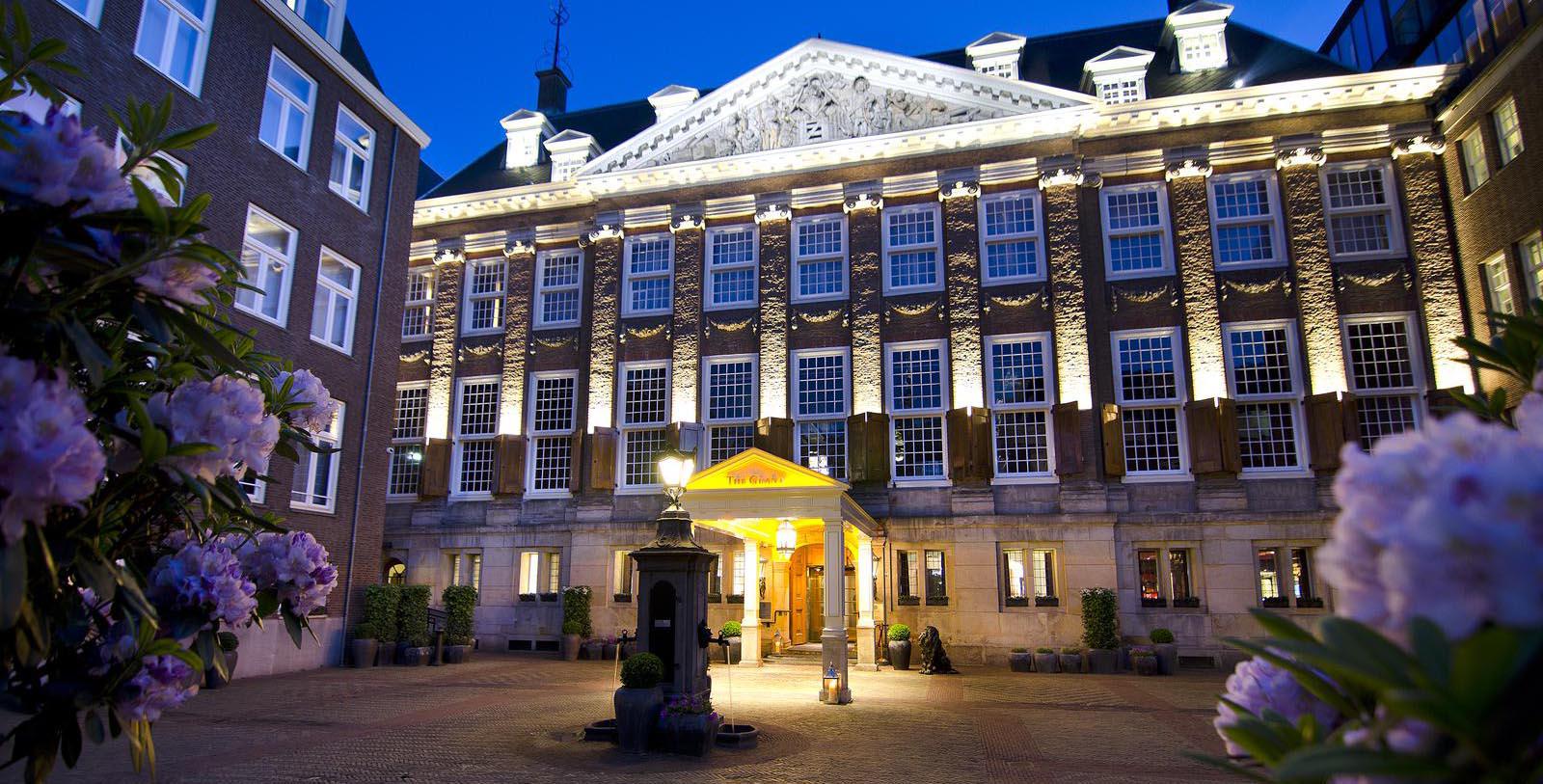Receive for Free - Discover & Explore eNewsletter monthly with advance notice of special offers, packages, and insider savings from 10% - 30% off Best Available Rates at selected hotels.
history
Discover the history of the Sofitel Legend The Grand Amsterdam, which has hosted European dignitaries as early as the 16th century.
Sofitel Legend The Grand Amsterdam, a member of Historic Hotels Worldwide since 2018, dates back to 1578.
VIEW TIMELINEA member of Historic Hotels Worldwide since 2018, the history of Sofitel Legend The Grand Amsterdam dates back centuries. In 1411, two convents—St. Catherine’s and St. Cecilia’s—began residing in the structure that is now The Grand Amsterdam. The two religious orders continued to use the site for the next couple hundred years until the onset of the Protestant Reformation a century later. In its wake, government officials confiscated the buildings for more civic-minded purposes. As such, the city allowed for the location’s transformation into a hotel called the “Lodgement voor Princen en Groote Heeren” (Lodging for Princes and Gentlemen of Standing) in 1578. Later renamed the “Princenhof,” the buildings hosted some of the most esteemed guests in European society for the next 69 years. Dutch royalty lodged at the Princenhof frequently, including Prince William the Silent, as well as his sons, Prince Maurice of Nassau and Prince Frederik Hendrik. A French queen named Maria de Medici also stayed at the Princenhof, while she worked to resolve a familial dispute with her son, King Louis XIII. The city briefly abandoned the Princenhof in 1647, when it built a new royal lodge called the “Oudezjds Herenlogement” (Old Side Hostel for Gentlemen). The buildings then served as the temporary City Hall a decade later after the previous one had burnt down. Meanwhile, the Dutch Admiralty had long desired to use the buildings as their headquarters. Once the city vacated the buildings again, the Admiralty acquired the site and occupied it for next two centuries. The Dutch Admiralty heavily renovated the buildings during this period, adding new brick walls and a wide façade to the front of the location.
When Napoleon Bonaparte invaded the Netherlands in the early 19th century, he installed his brother, Louis, as the reigning monarch of the Netherlands. Louis fell in love with the City Hall in Dam Square, seizing it for his personal palace. After Napoleon’s defeat at the Battle of Waterloo, city officials started using the Princenhof as Amsterdam’s City Hall yet again. The municipal offices for City Hall then remained at the Princehof buildings for the next 180 years! It subsequently played host to many fantastic events in the city’s more modern history, such as hosting the wedding between the future Queen Beatrix and her husband, Claus von Amsberg in 1966. But during the late 20th century, city officials moved City Hall for a final time to a new building in Dam Square, leaving the Princehof vacant for some time. Fortunately in 1992, the complex obtained a new lease on life when AccorHotels obtained the location. AccorHotels immediately began a massive renovation, which transformed the historic site into a brilliant boutique hotel called “The Grand Amsterdam.” The restoration proved to be a massive success, as The Grand Amsterdam quickly established itself as one of the city’s most popular retreats. To capitalize upon the business’ success, AccorHotels decided to launch another spirited makeover of the structure in 2011. When the second round of renovations concluded several years later, AccorHotels added the hotel into its renowned Sofitel Legends brand. The new “Sofitel Legend The Grand Amsterdam,” then went on to win 26 different awards that year for its renowned hospitality and service.
-
About the Location +
The Sofitel Legend The Grand Amsterdam resides right in the midst of the celebrated Amsterdam Canal District. Not only does this beautiful neighborhood constitute the city’s historic downtown, it is also an incredibly popular UNESCO World Heritage Site. Amsterdam itself is filled with history, having been founded generations ago at the height of the Middle Ages. Toward the end of the 12th century, a small vishing village emerged amid the marshes that surrounded the Amstesl River. Over time, the residents also developed a dam nearby, which caused many to refer to the settlement as “Amsterdam.” (The original name was actually Amstelledamme before its reduction to just “Amsterdam.”) Interestingly, the dam eventually served as the focal point for the town, with its market square and first streets extending outward from it. But Amsterdam grew slowly, as the local floodplains discouraged widespread agriculture. Instead, the earliest inhabitants traded herring and beer as a way to earn a living. Fortunately, the town’s fortunes started to change once Floris V, Count of Holland, granted the citizens the right to trade freely with its adjacent communities. Amsterdam’s nascent trade network flourished over the next few centuries, growing large enough to conduct regular commercial transactions with the powerful Hanseatic League. The settlement’s population rapidly exploded, with Amsterdam evenutally gaining the status of a city in the early 14th century.
As Amsterdam began to emerge as an important European metropolis, the city—as well as the rest of the medieval Netherlands—became a fiefdom to the Duke of Burgundy, Philip the Good. It subsequently remained a part of the Burgundian State until Philip’s distant descendant, Mary of Burgundy, married Archduke Maximilian Habsburg. The Austrian Habsburgs would then rule over the region for years, with the Holy Roman Emperor Charles V leaving the entire country to his son, King Philip II of Spain. But the Dutch in both Amsterdam and the greater Netherlands ultimately rose up against the Habsburgs, fighting a war of independence known as the “Eight Years’ War.” Upon winning their independence at the conclusion of the conflict in 1568, the Dutch further enhanced Amsterdam’s standing as a continental trading hub. Powerful financial guilds emerged throughout the city, who subsequently established some of the first European banks. The merchants also established a mighty navy, which allowed Amsterdam’s inhabitants to trade—and even colonize—many areas throughout the Americas, Africa, and Southeast Asia. Even more wealth flowed into Amsterdam, enabling its residents to construct some of the finest architecture ever seen in Europe. Among the gorgeous structures developed included the Westerkerk, the Zuiderkerk, and the Koninklijk Paleis van Amsterdam (otherwise known as the “Royal Palace of Amsterdam”). Local engineers were even empowered to develop a series of canals to serve as a means of transportation, defense, and water management. Soon enough, visiting merchants were calling Amsterdam the “Venice of the North.”
The Dutch Golden Age eventually came to an end around the 17th century, when the Netherlands became embroiled in several expensive wars. Those conflicts significantly drained the republic of its finances, with even the Amsterdam Stock Market crashing during the tumultuous Franco-Dutch War of the 1670s. Amsterdam nonetheless remained one of Europe’s most economically vibrant cities well into the following centuries. Despite brief periods of economic recession during the Napoleonic Wars and World War II, Amsterdam has since retained its status as one of Europe’s most prosperous communities. Amsterdam continues to be an important regional financial center, with the Amsterdam Stock Market regarded as the most historic of its kind today. Products still flow frequently into the Port of Amsterdam, which is the fifth largest on the continent. Dozens of leading Dutch companies keep their headquarters in the city—like Philips, AkzoNobel, and ING—while many other international corporations use the city as their base of operations. Amsterdam is deemed to be the Netherlands’ cultural capital, as well, known particularly for its exciting nightlife and festivals. But the city is also a fantastic tourist destination, as its hosts millions of visitors from across the globe every year. Most are attracted to its fantastic variety of cultural attractions and landmarks, such as the Rijksmuseum, the Van Gogh Museum, the Stedelijk Museum, the Concertgebouw, the Scheepvaartmuseum, the Anne Frank House, the Hortus Botanicus Amsterdam, and of course, the many ubiquitous canals.
-
About the Architecture +
The Sofitel Legend The Grand Amsterdam displays a beautiful blend of Dutch Baroque architecture. This unique architectural style emerged during the Dutch Golden Age of the 17th century, in which merchants throughout The Netherlands—flush with cash—began erecting magnificent residences and municipal offices. The Dutch architects borrowed heavily from the design principles of the Italian Renaissance, employing similar structural themes like giant order pilasters, gable roofs, and beautiful steeples. Yet, in keeping with the democratic traditions of the early Dutch Republic, these architects opted to embrace a less ostentatious aesthetic derived from earlier Neoclassical examples. Hendrick de Keyser served as the catalyst for this new architectural movement, as his work on the Noorderkerk and the Westerkerk in Amsterdam inspired subsequent generations across The Netherlands. Many other iconic buildings showcasing Dutch Baroque architecture quickly appeared in the country, including the Huis ten Bosch in The Hague and the City Hall in Maastricht. The movement continued unabated in Amsterdam as well, with grand structural masterpieces—like the Koninklijk Paleis van Amsterdam—emerging throughout the city for the remainder of the century.
-
Famous Historic Guests +
William I, Prince of Orange (1544 – 1584)
Maurice of Orange (1618 – 1625)
Frederick Henry, Prince of Orange (1625 – 1647)
Queen Marie de’ Medici of France (1600 – 1610)
Winston Churchill, Prime Minister of the United Kingdom (1940 – 1945; 1951 – 1955)
Queen Beatrix of the Netherlands (1980 – 2013)


























